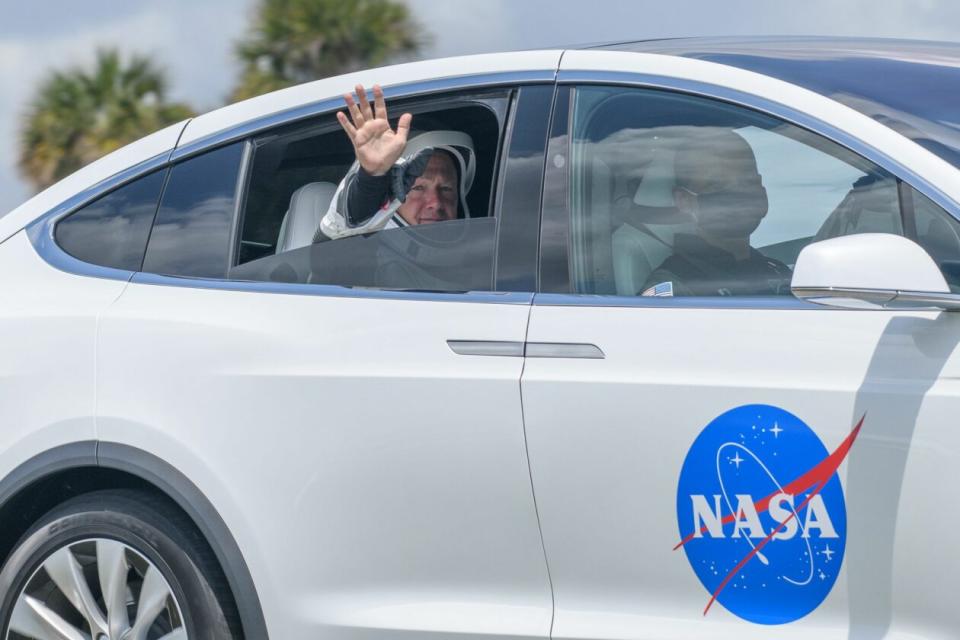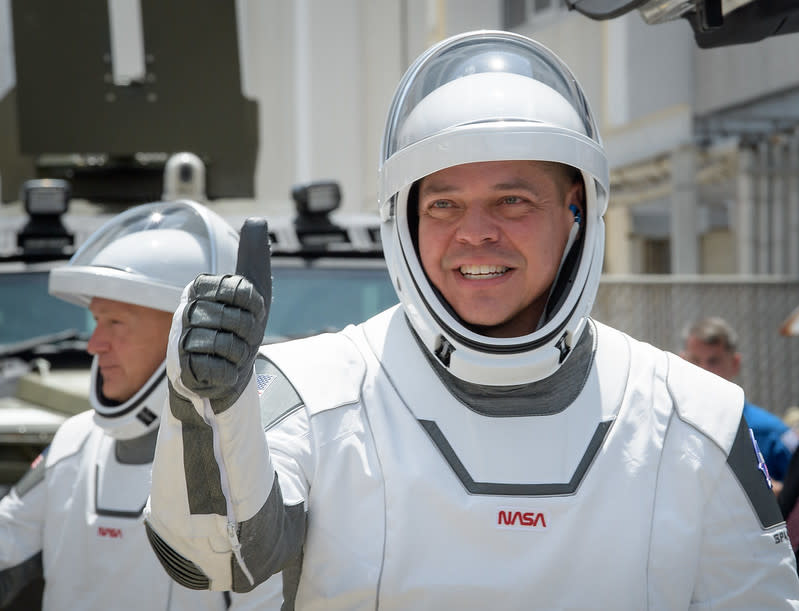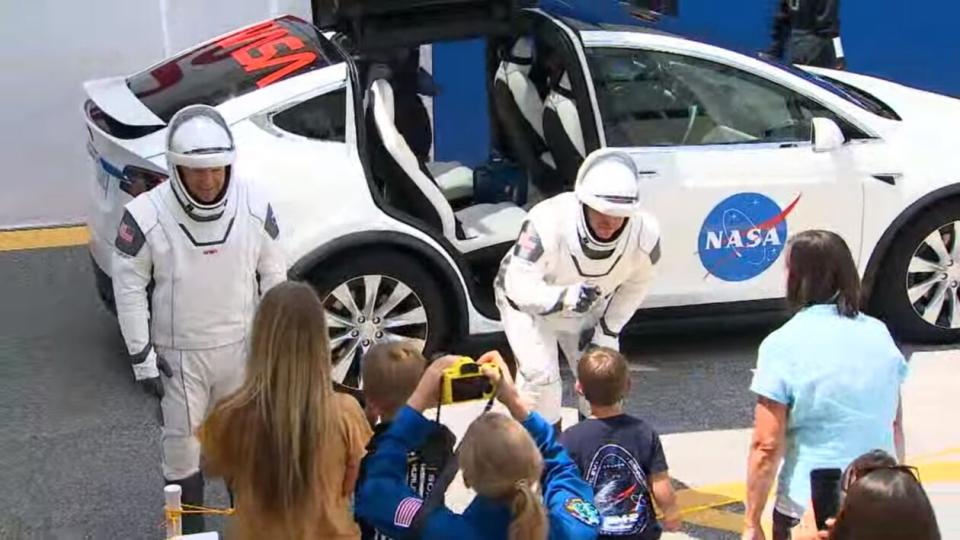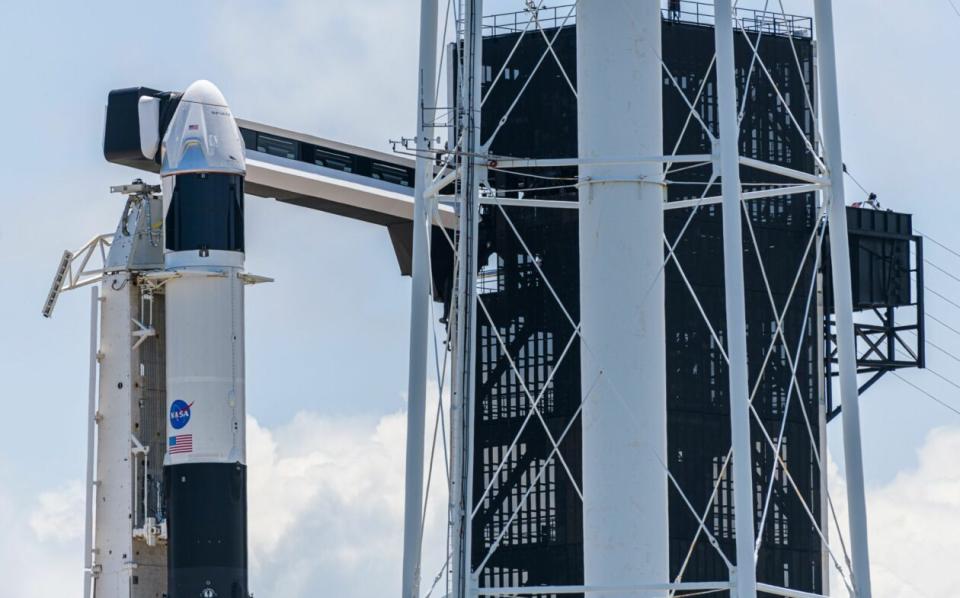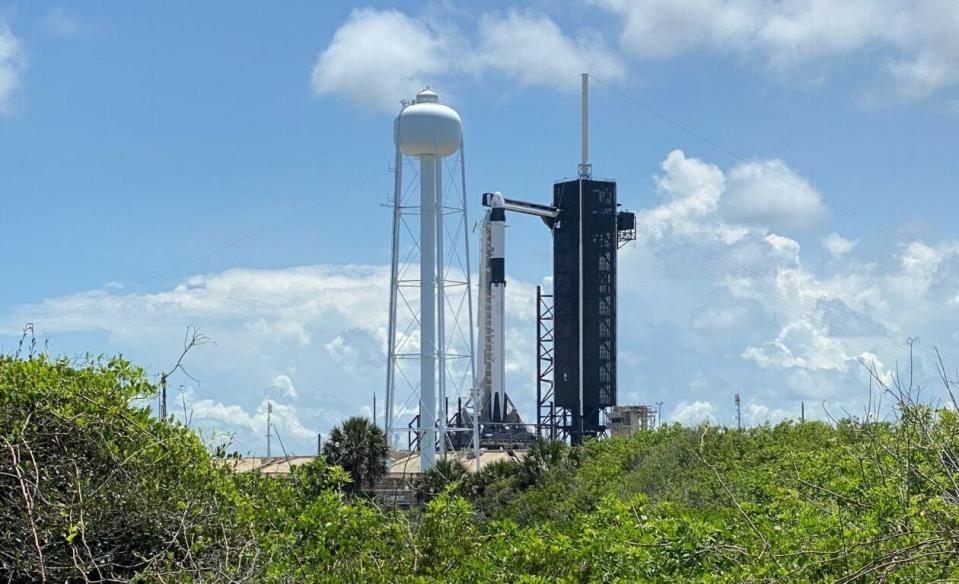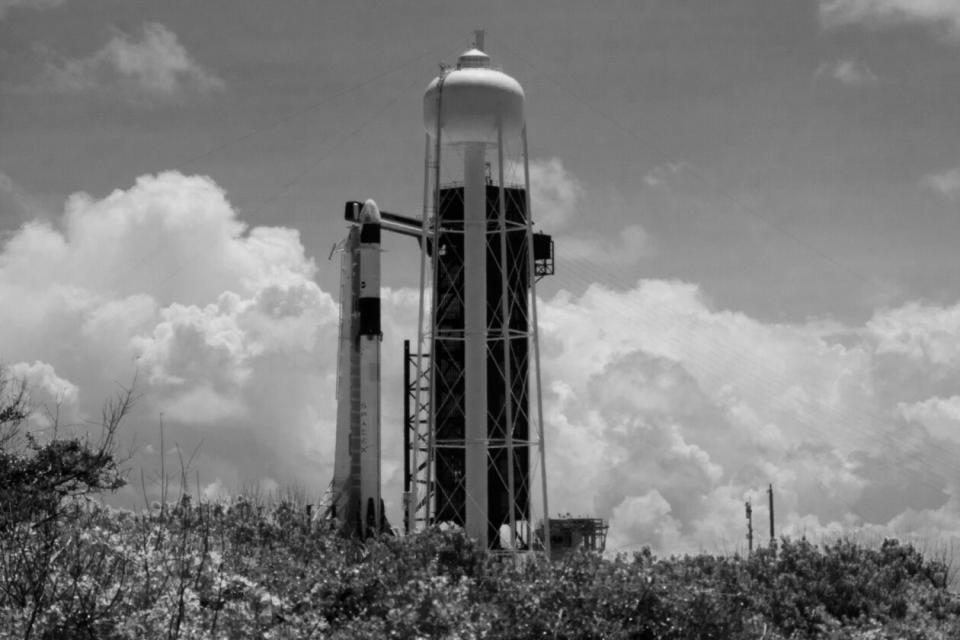‘Light this candle!’ SpaceX sends NASA astronauts on historic trip to space station in Dragon capsule
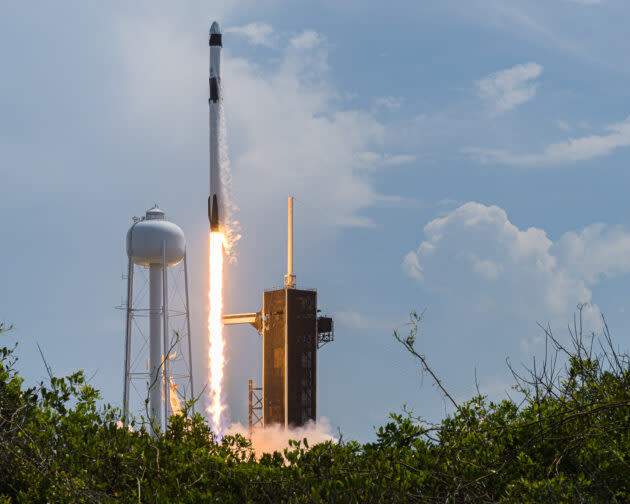
SpaceX launched two NASA astronauts to the International Space Station today, becoming the first company to send humans to orbit on a commercial spaceship.
The Falcon 9 rocket’s liftoff from NASA’s Kennedy Space Center in Florida at 3:22 p.m. ET (12:22 p.m. PT) marked a feat that Americans hadn’t been able to do since NASA retired the space shuttles in 2011: sending astronauts into orbit from a U.S. launch pad rather than relying on the Russians.
“It is absolutely our honor to be part of this huge effort to get the United States back in the launch business,” NASA astronaut Doug Hurley told SpaceX Mission Control just before liftoff.
President’s pride: Donald Trump hails space effort as a force for unity
NASA Administrator Jim Bridenstine got emotional as he reflected on the achievement. “It’s been nine years since we’ve launched American astronauts on American rockets from American soil, and now it’s done,” he said on NASA TV. “We have done it. It’s been way too long.”
SpaceX CEO Elon Musk was similarly emotional, to the point that he sometimes found it hard to speak during a post-launch news conference.
“This is something that should really get people right in the heart, of anyone who has any spirit of exploration,” he said. “It’s something that humanity should be excited about and proud of occurring on this day.”
No technical issues arose during today’s countdown, but the weather made it a nail-biter, just as it did during Wednesday’s initial launch attempt.
On that day, dark clouds and the accompanying risk of lightning forced a postponement. This morning, the weather forecast was 50-50, but the skies cleared enough for Hurley and his crewmate, Bob Behnken, to ride SpaceX’s Crew Dragon capsule eastward into orbit.
Ships were strategically placed in the Atlantic Ocean just in case an emergency abort and splashdown was required. (It wasn’t required.) Minutes after launch, the Falcon 9’s reusable first-stage booster successfully touched down on SpaceX’s drone ship, christened Of Course I Still Love You.
Pandemic or no pandemic, thousands of spectators flocked to roadside viewing areas surrounding the launch site. Tickets to watch the liftoff from the newly reopened Kennedy Space Center Visitor Complex were sold out, and all visitors have to wear masks and undergo temperature checks.
NASA asked people to stay home and watch the launch online or on TV. More than 10 million were watching via NASA and SpaceX at the peak, the space agency said.
The launch-day routine began with Hurley and Behnken having breakfast and suiting up. A small contingent, including the astronauts’ families, cheered as they walked out from NASA’s Operations & Checkout Building for their ride to the launch pad.
In accordance with the social distancing requirements for spaceflight as well as the coronavirus pandemic, Behnken arced his arms in a “virtual hug” for his wife, astronaut Megan McArthur, and their son. “Are you going to be on good behavior?” Behnken could be heard asking his son. “Are you going to listen to Mommy and make her life easy?”
“Let’s light this candle!” his son replied, echoing a phrase used by astronaut Alan Shepard just before America’s first spaceflight in 1961.
“Let’s light this candle, I agree!” Behnken said. “Launch America!”
Then he and Hurley headed to the pad in a Tesla Model X SUV, an update on the traditional “Astrovan” that’s also a nod to SpaceX CEO Elon Musk’s other company. SpaceX’s launch-pad ninjas — so named because of their black uniforms, caps and masks — strapped the astronauts into their seats and closed the hatch for launch.
Perhaps not so coincidentally, the last words that were heard from Hurley before liftoff were, “Light this candle!”
Just after the Crew Dragon made it to orbit, Hurley told SpaceX’s Falcon 9 team that the ascent was “incredible.”
“Thanks for the great ride to space,” he said.
Hurley and Behnken, who are both experienced shuttle astronauts, are scheduled to rendezvous with the space station on Sunday after a 19-hour trip. They’ll move in alongside the station’s current occupants, NASA’s Chris Cassidy and Russia’s Anatoly Ivanishin. NASA hasn’t yet decided how long the Dragon riders will spend in orbit. Their stay could be as short as six weeks, or as long as 16 weeks, depending on how the test mission proceeds.
For the return trip, Hurley and Behnken will strap themselves back inside the Dragon and descend to an Atlantic splashdown.
This whole flight serves as an initial demonstration of the Crew Dragon’s capabilities with an actual crew aboard. If the mission is successful, yet another Crew Dragon will carry four different astronauts to the space station weeks after Hurley and Behnken return.
Having the Crew Dragon would free NASA from having to pay the Russians upwards of $80 million a seat for rides to and from the space station, which is the whole point of the commercial crew program.
Back in 2014, NASA pledged $4.2 billion to Boeing and $2.6 billion to SpaceX to develop spacecraft that would essentially provide taxi rides to orbit. SpaceX built an upgraded version of its robotic cargo-carrying Dragon, which has been used for space station resupply since 2012. Boeing built a whole new spaceship called the CST-100 Starliner.
The Crew Dragon flew a successful uncrewed test mission in March 2019, but the Starliner suffered glitches during its uncrewed test flight to orbit last December. Now Boeing will have to redo Starliner’s robotic test, giving SpaceX a clear shot at making space history (and winning a capture-the-flag contest in the process).
It’s important to note that SpaceX, not NASA, owns the space-taxi hardware — just as a terrestrial taxi company owns the car. NASA has put in orders to ferry up to four astronauts at a time, but SpaceX can fly other riders as well.
A new name in space: Crew Dragon’s astronauts christen their spaceship
In partnership with Space Adventures, the company is already offering free-flying orbital trips that would go higher than the space station. There’s even talk of having Tom Cruise ride the Dragon to the space station to film a movie. That would require NASA’s go-ahead, but on Wednesday, Bridenstine said he’s “all for that.”
“I really think, when we look into the future, we’re going to see these models of doing business with public-private partnerships apply not just to low Earth orbit … but we’re taking this model to the moon and even on to Mars,” he said.
Amazon CEO Jeff Bezos’ space venture, Blue Origin, is already heading one of the teams aiming to develop lunar landers for NASA’s use. So is SpaceX, which is offering its next-generation Starship super-rocket. The next space race to watch may not be the U.S. vs. China so much as it is Bezos vs. Musk.
This report was first published at 7:45 a.m. PT May 30 and updated frequently since then.
More from GeekWire:
A date with history: NASA and SpaceX schedule first crewed Dragon mission for May 27 launch
Weather forces delay for SpaceX’s historic launch of NASA’s first Dragon riders to the space station
NASA chief points to SpaceX crewed launch as a unifying moment for America
Closer than humanly possible: New launch pad photos capture historic SpaceX liftoff in all its glory
